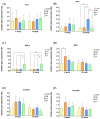Live Multi-Strain Probiotics Enhance Growth Performance by Regulating Intestinal Morphology and Microbiome Population in Weaning Piglets
- PMID: 39597723
- PMCID: PMC11596860
- DOI: 10.3390/microorganisms12112334
Live Multi-Strain Probiotics Enhance Growth Performance by Regulating Intestinal Morphology and Microbiome Population in Weaning Piglets
Abstract
The effects of different forms of multi-strain probiotics on weaning piglets are limitedly addressed. Thus, this study investigated the effects of live or inanimate multi-strain probiotics comprising Lactobacillus plantarum, Streptococcus thermophilus, and Bacillus subtilis on growth performance, intestinal morphology, fecal microbiota, short-chain fatty acids, and intestinal gene expression of weaning piglets. A total of 160 weaning piglets (4 weeks old) were randomly allocated into four treatments (CON: basal diet; AB: basal diet with 110 ppm and 66 ppm colistin in the weaning and nursery phases, respectively; LP: basal diet with 2.0 × 109 CFU/kg live probiotics; and IP: basal diet with 2.0 × 109 CFU/kg inanimate probiotics). Piglets fed with LP had significantly lower FCR compared to those of the CON and IP groups in week 4 to week 8 (p < 0.05). Moreover, the LP group had significantly higher villus height (VH) compared with AB at week 6, lower crypt depth (CD) compared with IP, and higher VH/CD ratio compared to other treatments at week 10 (p < 0.05), which indicate healthier intestinal morphology. Probiotic treatments (LP and IP) increased Bifidobacterium population compared to CON at week 6 and lowered Enterobacteriaceae at week 6 and week 10 (p < 0.05). Regarding gene expressions of intestinal integrity, LP showed significantly higher TFF3 expression compared with CON and AB at week 6 and compared with other treatments in jejunum at week 10 (p < 0.05). IP treatment had significantly higher MUC2 expression compared to other treatments at week 6 and week 10 (p < 0.05). Overall, live multi-strain probiotics improved growth efficiency by enhancing gut integrity and microbiome balance, making them a potential antibiotic alternative to ameliorate weaning stress and promote productive performance in weaning piglets.
Keywords: gene expression; growth performance; intestinal integrity; probiotics; weaning piglets.
Conflict of interest statement
Authors Ting-Yu Lee, Hsiao-Tung Chang, Hsiao-Ching Lin, Hsiu-Ming Weng, Hsin-Hsuan Huang, and Jin-Seng Lin were employed by SYNBIO TECH Inc. The remaining authors declare that the research was conducted in the absence of any commercial or financial relationships that could be construed as a potential conflict of interest.
Figures


References
-
- Lallès J.-P., Boudry G., Favier C., Le Floc’h N., Luron I., Montagne L., Oswald I.P., Pié S., Piel C., Sève B. Gut function and dysfunction in young pigs: Physiology. Anim. Res. 2004;53:301–316. doi: 10.1051/animres:2004018. - DOI
Grants and funding
LinkOut - more resources
Full Text Sources
Medical
Miscellaneous

